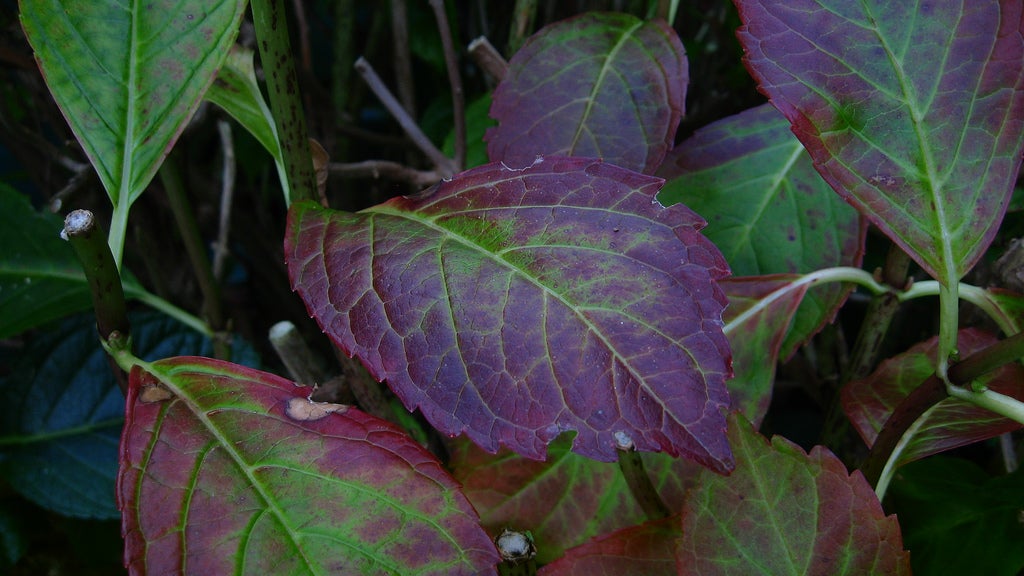Hydrangea Leaves Turning Purple: Treating Hydrangea Leaves That Turn Purple


Although the big, beautiful flowers of the hydrangea lend a certain merriness to the garden, the sudden appearance of purple leaves on these bushes may be enough to make a gardener cry. Read on if you own a hydrangea with purple leaves to learn about common causes of hydrangea leaves turning purple.
What Causes Purple Leaf Color on Hydrangeas?
Purple leaf color on hydrangeas isn't normal and may indicate fungal disease or simple environmental problems.
Fungal Disease
Purple spots on hydrangea leaves are a good indicator of cercospora leaf spot, a common leaf fungus in these plants. Plants are rarely killed, but spotted leaves may shed prematurely, weakening the plant and reducing viable buds. The small purple to brown spots usually start near the base of the plant, spreading outward and upward as water splashes the spores to other leaves. Spotting patterns vary based on the type of hydrangea involved. Slow the spread of cercospora by cleaning up fallen leaves and watering your hydrangea at the base. Opening the canopy by thinning up to a third of the branches inside a tightly packed hydrangea bush will increase air circulation, making it difficult for the spores to germinate. If cercospora is severe and widespread, azoxystrobin, chlorothalonil, mancozeb, myclobutanil, or thiophanate-methyl should be applied at 14 day intervals.
Phosphorus Deficiency
Hydrangea leaves that turn purple may be trying to tell you that there simply isn't enough phosphorus nearby to keep the plant healthy. Sometimes, in their rush to change their hydrangea's flower colors, gardeners may accidentally cause the pH to drop so low that other chemical compounds bind phosphorus. Bound phosphorus can't be used by plants, leaving them short vital nutrients. Check your soil pH-- acidic soils with pH below 6.0 often allow aluminum to tie up phosphorus, those alkaline soils with pH above 7.0 may be binding it with calcium or magnesium. Adjusting your soil's pH is the first step to freeing phosphorus, but if this doesn't show a noticeable difference in a couple of weeks, you will need to apply a phosphorus fertilizer to the hydrangea's root zone.
Weather's Influence
Weather can also influence the color of hydrangea leaves, causing large areas of purple discoloration. Cool weather near the end of the growing season may trigger the plant's dormancy early, allowing the purple leaf color to show through as the green chlorophyll factories shut down for the season. Frost damage can also cause a purple discoloration. Pluck off the badly damaged leaves when they dry out but leave those only partially injured behind until new leaves form.
Gardening tips, videos, info and more delivered right to your inbox!
Sign up for the Gardening Know How newsletter today and receive a free copy of our e-book "How to Grow Delicious Tomatoes".

Kristi Waterworth was a regular contributor to Gardening Know How for many years, answering countless queries on plant pests and diseases.
-
 12 Lush Alternatives To A Lawn For Sustainable Spaces
12 Lush Alternatives To A Lawn For Sustainable SpacesAlternatives to a lawn are beautiful and also beneficial to your local ecosystem and its pollinators. Explore our top picks for plants to replace grass.
By Tonya Barnett
-
 Types Of Tomatoes Explained: Explore The Many Wonderful Shapes, Colors, Flavors, & Best Uses
Types Of Tomatoes Explained: Explore The Many Wonderful Shapes, Colors, Flavors, & Best UsesThe world of tomato varieties is vast and fascinating. Learn about the key types to grow in your garden, tailored to your preferences and space.
By Amy Grant